Hold Harmless Agreement
Use our free hold harmless (indemnity) agreement to limit responsibility for harm or damages that may occur.
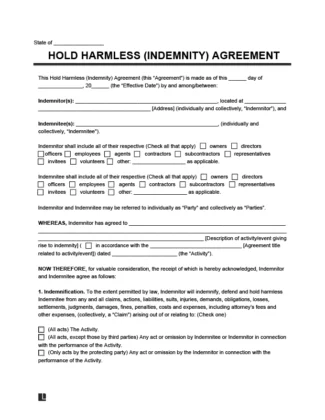
Updated December 14, 2023
Written by Sara Hostelley | Reviewed by Brooke Davis
A hold harmless agreement helps protect someone who hired a contractor or another individual from liability if they harm themselves while working for them. It acts as a form of insurance and lets people work together who might otherwise be unable to because of legal liability.
- What Is a Hold Harmless Agreement?
- Types of Hold Harmless Agreements
- When to Use A Hold Harmless Agreement
- Benefits of Using a Hold Harmless Agreement
- Do I Need to Separate My Hold Harmless Agreement?
- Do I Always Have to Use a Hold Harmless Agreement?
- How to Write a Hold Harmless (Indemnity) Agreement
- Hold Harmless Agreement Sample
What Is a Hold Harmless Agreement?
A hold harmless agreement is a legal contract that transfers risk from one party, the indemnitee, to another party, the indemnifier. The purpose of a hold harmless agreement is to minimize the risk of a potential lawsuit by holding one party harmless. In some cases, this document will hold both parties harmless.
You don’t need to get this document notarized for it to be valid. However, some institutions, like banks, could refuse the document if it’s not notarized due to having signing requirements in place. Check with the institution where you plan to use the document to ensure it doesn’t require notarization.
Is a Hold Harmless Agreement the Same as an Indemnity Agreement?
“Hold harmless” and “indemnity” are generally synonymous. However, these terms may have slightly different meanings depending on where you live.
- A hold harmless agreement can demand that an entity protect the other party against actual and potential losses.
- In contrast, an indemnity agreement can only order a party to protect another entity against actual losses.
Types of Hold Harmless Agreements
Explore the three main types of hold harmless agreements in the construction industry to understand the concept better:
- Broad-form: Broad-form hold harmless agreements transfer all the liability from the hiring party to the subcontractor. The subcontractor accepts responsibility for its negligence, the general contractor’s negligence, and negligence for which both parties are equally responsible. Many jurisdictions reject the use of this type.
- Intermediate-form: Intermediate-form hold harmless agreements state that the subcontractor is wholly responsible for their own actions. However, it also says that they can’t be liable for the general contractor’s negligence.
- Limited-form: Limited-form hold harmless agreements state that the subcontractor is only responsible for their proportional negligence. If the subcontractor and general contractor are negligent or cause an accident, the subcontractor will only have liability for their fraction of the incident.
More generally, a hold harmless agreement can be unilateral or bilateral. A unilateral hold harmless agreement only applies to one party, while a bilateral one applies to both.
When to Use A Hold Harmless Agreement
Engaging in business activities comes with some type of risk. A hold harmless agreement lets parties shift risk based on their needs and protect themselves against future lawsuits or losses. It incentivizes parties to enter into contracts they’d otherwise hesitate to sign.
Here are some examples of where you may use a hold harmless agreement:
- Hiring or working as a contractor: Contractors and subcontractors use hold harmless agreements to distribute responsibility for property damage, personal injuries, or accidents that could occur on construction sites.
- Leasing a property: Landlords and tenants may introduce hold harmless clauses to address liabilities relating to property alterations, maintenance, or use.
- Buying real estate: Sellers can limit their liability for property defects, title disputes, and environmental concerns. Buyers may agree to hold the seller harmless under specific conditions.
- Sponsoring or hosting an event: Property owners and event organizers use these clauses to allocate responsibility for incidents that may occur during a wedding, graduation party, or another event.
- Facilitating potentially risky activities: If you’re having someone engage in a sport or participate in an adventurous activity, you may use a hold harmless agreement to minimize your liability if they sustain a personal injury.
- Providing a service: If you have a business contract in which you provide a service to another entity, you can use a hold harmless clause to protect yourself from legal claims resulting from the outcome of your services. You can also state that you’re not responsible for omissions or errors that may arise while you work.
- Hiring an employee: Employers may have employees sign hold harmless agreements to ensure the employers are harmless for any decisions or actions the employees make while they work.
Example Scenario
Suppose you wanted to remodel your kitchen. You may be reluctant to hire a contractor to come into your home. The contractor may want to sue you if they or one of their employees sustains a bodily injury while performing work at your residence.
By having the contractor sign a hold harmless agreement, you can protect yourself against a lawsuit.
When the contractor signs this agreement, they promise not to sue if they get injured. Also, suppose the contractor’s employee gets hurt and sues you. In that case, the contractor will have to defend the suit or reimburse you for your expenses in defending the claim.
Furthermore, suppose the contractor accidentally drops your old kitchen sink onto the neighbor’s new car. This document can absolve you of any responsibility for the damage. It can also protect you against third-party claims.
Benefits of Using a Hold Harmless Agreement
Explore the significant benefits of having a hold harmless agreement:
- Reduced Risk of a Lawsuit: With this type of agreement, you can reduce your risk of a lawsuit. A person signing the agreement will know they cannot file a lawsuit against you in most circumstances because they have already agreed to hold you harmless.
- Fewer Legal Expenses: If you mitigate your chances of facing a lawsuit, you can also reduce potential legal expenses. Because you can avoid having a party file a lawsuit against you, you may not have to hire an attorney to represent and defend you.
- Limited Negative Public Exposure: You can also reduce potential negative public exposure. If someone files a lawsuit against you, the public knowledge of this suit can harm your brand reputation even if you win. Protecting yourself against a lawsuit also means protecting your brand identity for the long term.
Here are some sufferings this agreement could help avoid:
| Promisor | Promisee |
|---|
Lost Money
- Unable to get a job or contract
- Did not obtain proper insurance | Lost Money
- Responsible for unanticipated losses and liabilities
- Did not obtain proper insurance |
Lost Time
- Extended argument involving attorneys in a courtroom | Lost Time
- Time spent fighting legal battles instead of building a business |
Mental Anguish
- Prolonged problem hanging over your head | Mental Anguish
- Fear of hiring another contractor |
Do I Need to Separate My Hold Harmless Agreement?
Hold harmless agreements can be effective ways to protect a party from liability whether they’re separate or a clause within another agreement.
Regardless of their form, a hold harmless agreement always connects to an activity associated with risk. It’s up to the parties’ discretion to separate this agreement or include it in a larger document.
Some examples of situations when you could benefit from having a separate hold harmless agreement include the following:
- You want to incentivize a potential board member to work for you, holding them harmless for any decisions they make while on your company’s board.
- You can use this document as a condition for releasing company information and to prevent liabilities that may arise from exploiting that information.
- You can use this agreement to verify that customers know the risks of an activity even if they don’t read your company’s contract.
Do I Always Have to Use a Hold Harmless Agreement?
A hold harmless agreement provides great benefits in many scenarios. However, it’s not always unnecessary, especially in two main instances:
- When the risk is implied: Some activities have inherent and obvious risks. For example, if you attend a soccer match, there’s an inherent risk of a ball hitting a spectator or a stampede because of the large crowds. Because of the innate risks involved with this kind of event, you likely won’t need to make spectators sign a hold harmless agreement.
- When it’s impractical: It might be impractical for businesses to get every customer to sign a hold harmless agreement. For example, a grocery store can’t realistically stop every customer and ask them to sign an agreement before they shop. Instead, the grocery store managers follow realistic protocols, like cleaning spills promptly, to minimize their liabilities.
It might be a good idea to have a hold harmless agreement. Even if the non-offending party chooses not to enforce the hold harmless agreement when a breach occurs, they can still implement it in the future whether the breach is of the same or other covenant or condition.
How to Write a Hold Harmless (Indemnity) Agreement
Step 1 – Write the Parties’ Information
Record the date you’re writing the agreement. Include the names of the indemnitor and indemnitee. Specify whether the agreement includes others, such as either party’s owners, directors, officers, employees, agents, representatives, volunteers, contractors, subcontractors, and invitees.
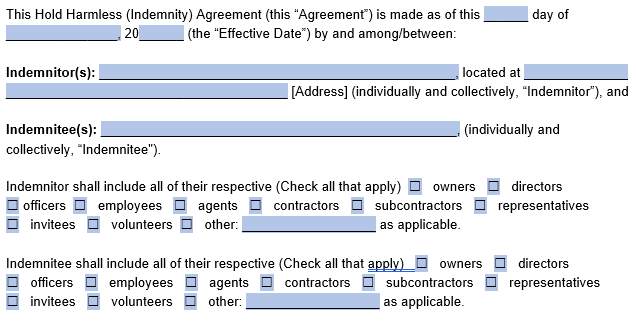
Step 2 – Outline the Agreement and Indemnification
Outline what the indemnitor agrees to, describing the activity or event giving rise to indemnity. Then, detail what acts the indemnification relates to and any indemnity limits.
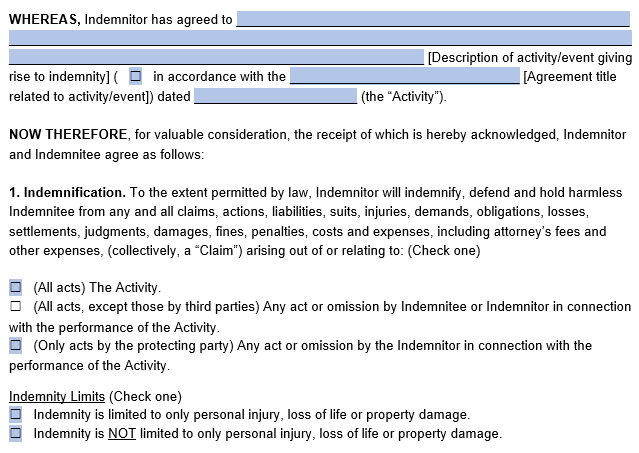
Step 3 – Exceptions and Notice of Claim
Next, describe any exceptions relating to the indemnity and if there’s a cap on the indemnity amount. You should also include how much notice of any claim the indemnitee must prove to the indemnitor.
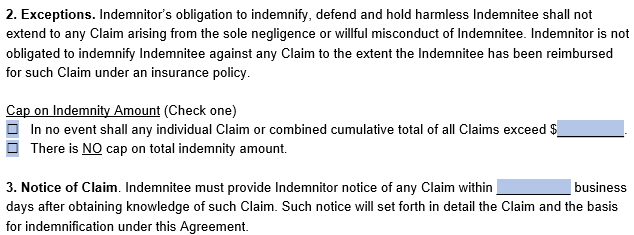
Step 4 – State Dispute Resolution Procedures
This section includes how the parties will resolve any disputes that arise from the agreement. For example, you may indicate that you want to resolve disputes via court litigation or mediation.
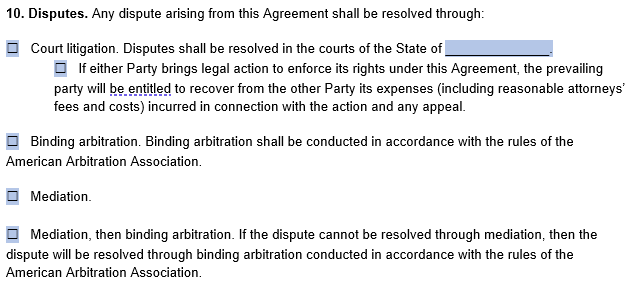
Step 5 – Obtain Signatures
Finally, both the indemnitor and indemnitee must sign the agreement.

The enforceability of your hold harmless agreement will depend on its intended use, your specific state laws, and how the courts interpret its application.
Hold Harmless Agreement Sample
Download a hold harmless agreement template as a PDF or Word file below:
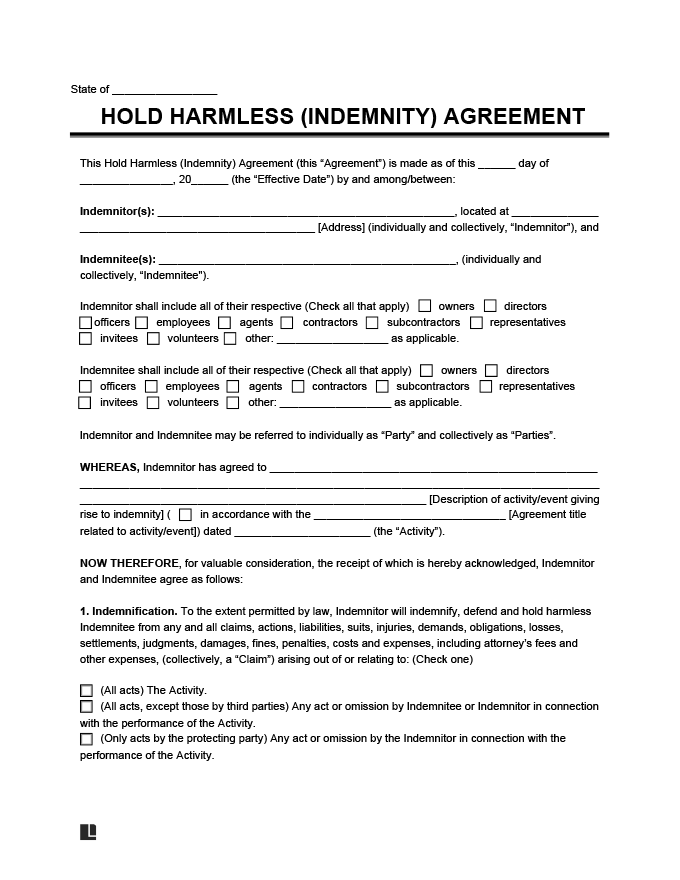
- Release of Liability (Waiver): Prohibit one party from suing another in the event of an accident.
- Business Contract: An agreement in which each party agrees to an exchange, typically involving money, goods, or services.
- Independent Contractor Agreement: Use this document to describe the services performed by an independent contractor or freelancer for another business.
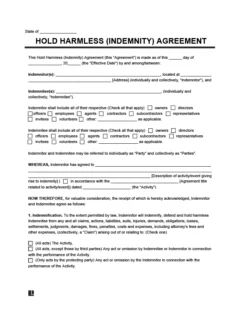
Create Your Hold Harmless Agreement in Minutes!









